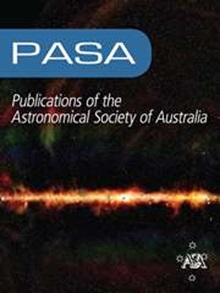A Near-Field Treatment of Aperture Synthesis Techniques using the Murchison Widefield Array
IF 4.6
3区 物理与天体物理
Q1 ASTRONOMY & ASTROPHYSICS
Publications of the Astronomical Society of Australia
Pub Date : 2023-11-10
DOI:10.1017/pasa.2023.56
引用次数: 0
Abstract
Abstract Typical radio interferometer observations are performed assuming the source of radiation to be in the far-field of the instrument, resulting in a two-dimensional Fourier relationship between the observed visibilities in the aperture plane and the sky brightness distribution (over a small field of view). When near-field objects are present in an observation, the standard approach applies far-field delays during correlation, resulting in loss of signal coherence for the signal from the near-field object. In this paper, we demonstrate near-field aperture synthesis techniques using a Murchison Widefield Array observation of the International Space Station (ISS), as it appears as a bright near-field object. We perform visibility phase corrections to restore coherence across the array for the near-field object (however not restoring coherence losses due to time and frequency averaging at the correlator). We illustrate the impact of the near-field corrections in the aperture plane and the sky plane. The aperture plane curves to match the curvature of the near-field wavefront, and in the sky plane near-field corrections manifest as fringe rotations at different rates as we bring the focal point of the array from infinity to the desired near-field distance. We also demonstrate the inverse scenario of inferring the line-of-sight range of the ISS by inverting the apparent curvature of the wavefront seen by the aperture. We conclude the paper by briefly discussing the limitations of the methods developed and the near-field science cases where our approach can be exploited.Murchison宽场阵列孔径合成技术的近场处理
典型的射电干涉仪观测假设辐射源在仪器的远场,导致在孔径平面上观测到的可见度与天空亮度分布之间的二维傅立叶关系(在小视场上)。当观测中存在近场目标时,标准方法在相关过程中应用远场延迟,导致来自近场目标的信号失去相干性。在本文中,我们演示了使用国际空间站(ISS)的默奇森宽场阵列观测的近场孔径合成技术,因为它看起来像一个明亮的近场物体。我们执行可见相位校正来恢复近场目标在整个阵列上的相干性(但是由于相关器的时间和频率平均而无法恢复相干性损失)。我们举例说明了近场校正在孔径平面和天平面上的影响。孔径平面弯曲以匹配近场波前的曲率,而在天空平面上,当我们将阵列的焦点从无穷远处移到所需的近场距离时,近场修正以不同速率的条纹旋转表现出来。我们还演示了通过反演光圈看到的波前表观曲率来推断ISS视线范围的反情景。我们通过简要讨论所开发方法的局限性和我们的方法可以利用的近场科学案例来结束本文。
本文章由计算机程序翻译,如有差异,请以英文原文为准。
求助全文
约1分钟内获得全文
求助全文
来源期刊
CiteScore
5.90
自引率
9.50%
发文量
41
审稿时长
>12 weeks
期刊介绍:
Publications of the Astronomical Society of Australia (PASA) publishes new and significant research in astronomy and astrophysics. PASA covers a wide range of topics within astronomy, including multi-wavelength observations, theoretical modelling, computational astronomy and visualisation. PASA also maintains its heritage of publishing results on southern hemisphere astronomy and on astronomy with Australian facilities.
PASA publishes research papers, review papers and special series on topical issues, making use of expert international reviewers and an experienced Editorial Board. As an electronic-only journal, PASA publishes paper by paper, ensuring a rapid publication rate. There are no page charges. PASA''s Editorial Board approve a certain number of papers per year to be published Open Access without a publication fee.

 求助内容:
求助内容: 应助结果提醒方式:
应助结果提醒方式:


